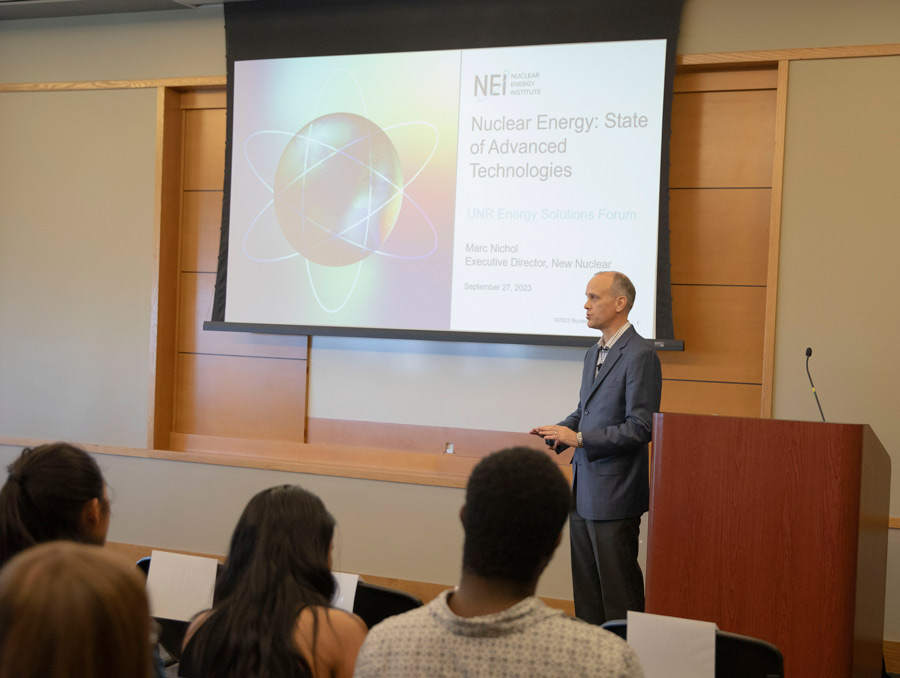In September, the Energy Solutions Forum continued with campus visits from another series of energy technology experts. The first speaker of the fall semester was Marc Nichol, who visited on September 27 to talk about nuclear energy. Nichol is the Executive Director of New Nuclear at the Nuclear Energy Institute, which advocates for the use of nuclear power and supports development of new nuclear.
Nichol spoke about new technologies, the safety measures being built into those technologies, the key benefits clean nuclear energy brings to the grid, and more. He also spoke about how nuclear waste can be safely and securely managed.
Nuclear waste disposal
When nuclear energy is produced, where does the radioactive material go? That’s one of the biggest questions that the industry has to answer, and one on the minds of many Nevadans.
Nichol said there are three things to think about with any technology’s waste stream: cost, safety and storage. Nichol said that safety is top priority for those working in nuclear.
“We have a strong safety culture and a lot of work behaviors around that,” Nichol said. “We learn from the past.”
As for cost, Nichol said the nuclear industry is unique in that money is set aside at the beginning of operations for the cost of managing waste, or used fuel, and for decommissioning.
Nichol pointed out that the amount of waste generated by nuclear power plants is relatively small. He said the total used fuel from 40 years of U.S. operations, which produced about 20% of the electricity generated in that time, would fit on a football field. Used fuel is very compact, and it’s in a solid form, which makes it easy to store safely, because radioactivity can be contained using steel and concrete. It can also be transported safely.
Nevadans may be particularly concerned about storage because of the location of Yucca Mountain, which has been legally designated as a storage site for nuclear waste. Underground burial in Yucca Mountain, located in southwestern Nevada, is a contentious issue. Nichol said there is a political discussion underway in Congress.
“Should we stick with Yucca Mountain, or should we go and find a new location based on a consent-based process, which is much more equitable than the process that was used to find Yucca Mountain?” Nichol asks. “I look at it this way, this decision that we’re going to make on where to store it is a ten-thousand-, hundred-thousand-year decision. So, it makes sense to take a few years now and get that decision right.”
Nichol also added that at some point, technology might arise that allows nuclear waste to be recycled, and having the material easily accessible for recycling would be important.
New technologies in nuclear
For Nichol, the most exciting part of the nuclear industry right now is the various technologies being developed, and how they can scale differently to different needs.
“That's why I'm most excited, because now we can use nuclear energy to decarbonize large amounts of not just the electricity grid, but other energy uses, primarily transportation and industrial,” Nichol said.
He also pointed out that the smaller size of reactors allows for new technologies to build on current safety measures by harnessing natural forces like gravity.
“Relying on natural phenomena results in a lot fewer complicated systems to achieve the same level of safety,” Nichol said. “That also helps to reduce the cost. So it's an area where cost and safety aren't opposed to each other, they actually go hand in hand.”
Nichol touted the reliability of nuclear when compared to other renewable energy sources. He spoke about the exciting advancements in fusion technology that took place last year, and the potential it holds, but focused on fission’s potential, as it’s a more usable and practical technology at this point.
The Nuclear Energy Institute hopes to support the development of 20 nuclear projects by 2030, and aims to match the energy produced to energy needs of the region these projects are being built in.
The Energy Solutions Forum brings experts in carbon-reduction technologies to the University to facilitate conversations and collaborations aimed at decreasing carbon emissions. Other speakers in the fall included Paul Voigt from Redwood Materials and Johanna Haggstrom from LanzaTech. The Energy Solutions Forum will continue in the spring semester with talks about batteries, fuels and more.
















